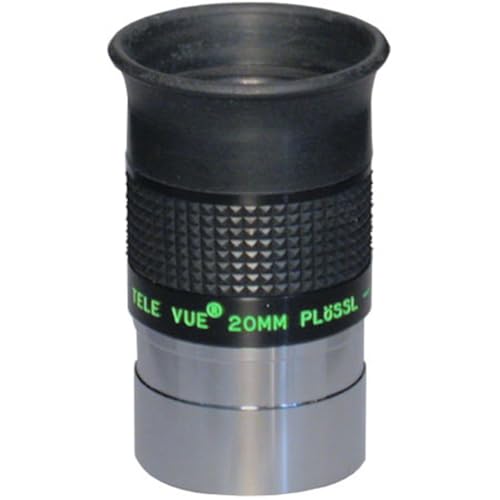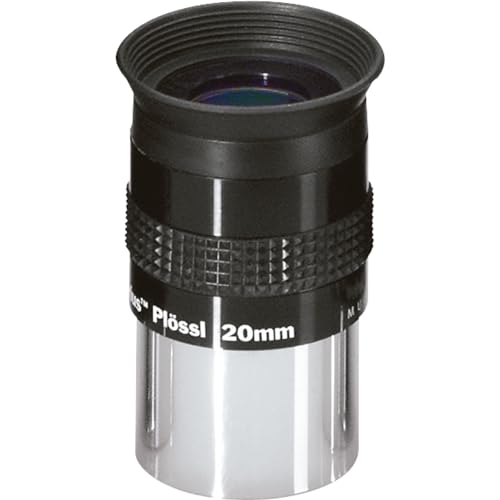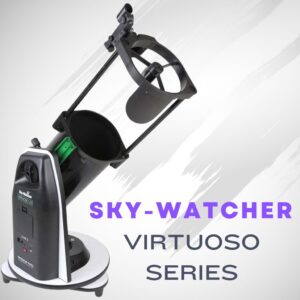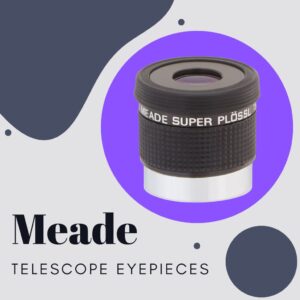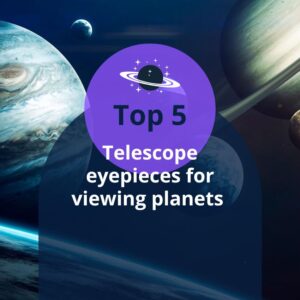This site contains affiliate links to products. I may receive a commission for purchases made through these links.
Choosing the right eyepiece is one of the most important decisions when buying a telescope. Eyepieces come in various focal lengths, and the choice between a 10mm and a 20mm eyepiece can significantly impact your viewing experience.
In this article, we will compare and contrast 10mm and 20mm eyepieces, examining the advantages and disadvantages of each and helping you make an informed decision on which eyepiece is best suited for your needs.
So, if you’re a beginner or a seasoned astronomer looking to upgrade your eyepiece collection, keep reading to discover the pros and cons of each and which one is the winner in the ultimate “eyepiece battle.”
Factors to consider when choosing between 10mm and 20mm eyepieces
When deciding between a 10mm and a 20mm eyepiece, there are several factors to consider. Here are some of them:
Magnification
Magnification is a crucial factor to consider when choosing an eyepiece. A 10mm eyepiece provides higher magnification than a 20mm eyepiece.
Eyepiece sharpness is important for clear and crisp views of celestial objects, especially at higher magnifications.
However, higher magnification does not always equal better image quality, especially in poor atmospheric conditions.
A 20mm eyepiece provides a wider field of view, which can be beneficial when observing larger objects or tracking objects moving quickly across the sky.
Telescope aperture
Telescope aperture is a major factor to take into account when choosing an eyepiece. The aperture of a telescope refers to its diameter, and it determines the amount of light the telescope can gather.
The larger the aperture, the more light the telescope can collect, resulting in brighter and more detailed views.
When choosing between a 10mm and 20mm eyepiece, the telescope aperture is especially important to consider because it affects the magnification power.
If you have a small telescope aperture, using a higher magnification eyepiece such as 10mm might result in a dim and blurry image.
In this case, a lower magnification eyepiece, like 20mm, would be a better choice, as it will provide a brighter and clearer view.
However, if you have a larger telescope aperture, a 10mm eyepiece might be a good option for viewing objects with great detail, such as planets.
You may also like: Telescope Magnification: Beginners Guide W/ Examples
Eyepiece focal length
The eyepiece focal lengths determine the magnification level and the field of view that can be obtained. A 10mm eyepiece typically has a shorter focal length than a 20mm eyepiece.
Generally, eyepieces with shorter focal lengths provide higher magnification.
However, the choice of focal length depends on the object being observed and the telescope’s focal length.
Field of view
The field of view refers to the amount of sky visible through the eyepiece. A 20mm eyepiece generally provides a wider field of view than a 10mm eyepiece.
However, a narrower field of view can be beneficial when observing smaller objects where a higher magnification is required.
Eyepiece diameter plays a crucial role in determining the field of view and the amount of light gathered by the telescope.
Eye relief
Eye relief is the distance between the eyepiece and the eye that provides a clear view of the object being observed. A 20mm eyepiece generally provides longer eye relief than a 10mm eyepiece.
Eyeglass wearers can still enjoy stargazing by choosing an eyepiece with longer eye relief.
What is a 10mm eyepiece suitable for?
A 10mm eyepiece is a good telescope accessory, providing a high-magnification view of celestial objects.
Let’s discuss in detail what a 10mm eyepiece is suitable for and provide recommendations for high-quality eyepiece brands.
Moon observation
Moon observation is a popular activity among astronomers. With a 10mm eyepiece, you can view the lunar surface in incredible detail. The craters, mountains, and valleys on the Moon can be seen with great clarity and sharpness.
Choosing the right eyepiece design, such as a Plossl or a Kellner, can affect image quality and contrast.
Some high-quality 10mm eyepiece brands for lunar observation include:
SVBONY Telescope Lens 10mm Eyepiece
The SVBONY Telescope Lens 10mm Eyepiece is a great choice for lunar observation, as it provides high magnification, which is necessary for viewing the fine details of the moon’s surface.
Its super wide angle 62-degree apparent field of view covers a wide range of magnifications and true fields of view, allowing you to see the moon in great detail.
Astromania 1.25″ 10mm Plossl Telescope Eyepiece
The Astromania 1.25″ 10mm Plossl Telescope Eyepiece is a great addition to any telescope, with features that make it ideal for lunar observation.
It is threaded for standard 1.25-inch astronomy filters and Barlow lens and comes with sturdy plastic dust caps that protect the eyepiece from dust and moisture.
The 4-element Plossl design offers an approximate 52-degree AFOV, giving the widest viewing field and extra sharpness and long eye relief.
Celestron Ultima Edge – 10mm Flat Field Eyepiece
The Celestron Ultima Edge – 10mm Flat Field Eyepiece is a high-quality telescope eyepiece designed to provide a clear and sharp image across the entire field of view.
It features fully multi-coated optics and a 5-element lens design that maximizes light transmission. With a 60-degree field of view, this eyepiece is ideal for viewing planets, stars, and the Moon’s surface at high power magnification.
Planetary observation
Planetary observation is a fun activity among astronomers. With a 10mm eyepiece, you can view planets like Jupiter, Saturn, and Mars in great detail.
You can observe Jupiter’s cloud bands, its four largest moons, and the Great Red Spot.
You can also see Saturn’s beautiful rings and its largest moon, Titan.
Some high-quality 10mm eyepiece brands for planetary observation are:
Orion 10mm Sirius Plossl Telescope Eyepiece
The Orion 10mm Sirius Plossl Telescope Eyepiece is a 1.25-inch eyepiece with a 10mm focal length, perfect for all types of telescopes, including reflectors, refractors, and catadioptrics such as Maksutov-Cassegrains.
This eyepiece is an excellent choice for higher-power planetary and lunar observations, providing clear and sharp images of impressively high contrast with its 52-degree apparent field of view.
Tele Vue 10mm Ethos-SX 2″ / 1.25″ Eyepiece
The Tele Vue 10mm Ethos-SX 2″ / 1.25″ Eyepiece is an ideal eyepiece for planetary viewing, delivering high contrast, distortion correction, and on-axis sharpness.
With a large apparent field of view of 100° and a shorter focal length, the eyepiece allows for a darker sky background and clearer views of fainter stars and deep sky objects.
It is compatible with all scopes that require this focal length and is a great centerpiece for a 17mm/10mm/6mm Ethos set.
What is a 20mm eyepiece suitable for?
A 20mm eyepiece provides moderate eyepiece magnification while also offering a wider field of view, making it suitable for a range of celestial objects, from planets and star clusters to nebulae and galaxies.
Planetary observation
A 20mm eyepiece is ideal for observing planets with larger apparent sizes, such as Jupiter and Saturn.
You can see more of the planet in the field of view, making it easier to observe and track any changes in the planet’s features over time.
Some high-quality 20mm eyepiece brands for planetary observation are:
Tele Vue 20mm Plossl 1.25″ eyepiece
The Tele Vue 20mm Plossl 1.25″ eyepiece is suitable for planetary observation due to its high-quality optics and design.
It features a 4-element lens design and is multi-coated for maximum light transmission, which provides clear, sharp views of celestial objects, including planets.
The Plossl design provides excellent color correction and reduces spherical aberration, making it a great choice for planetary and lunar observation.
WEOOEN 1.25inch Plossl Telescope Eyepiece 20mm lens
The WEOOEN 1.25-inch Plossl Telescope Eyepiece 20mm is an excellent choice for any astronomy enthusiast.
Crafted with high-quality optical glass and a durable metal construction, this eyepiece boasts a 4-element plossl design that delivers sharp and detailed images.
With a fully coated lens, this eyepiece is ideal for observing lunar craters, planetary nebulas, and other celestial objects.
The type of eyepiece lens, whether it’s made of glass or plastic, can impact image quality and color rendition.
It’s important to note that the level of magnification achieved depends on both the focal length of your telescope and the eyepiece used.
Moon observation
A 20mm eyepiece can be good for observing the Moon. It will provide a wider field of view and a lower magnification compared to shorter focal length eyepieces, which can be helpful in observing larger features on the Moon, such as craters, plains, and mountains.
However, remember that the eyepiece choice depends on various factors, such as the telescope’s aperture, focal length, and the observer’s preferences.
Orion 8923 20mm Expanse Telescope Eyepiece
The Orion 8923 20mm Expanse Telescope Eyepiece is suitable for moon observation. It has a 66-degree apparent field of view and multi-coated optics that provide clear and bright views of the moon’s surface.
The 20mm focal length also offers a comfortable magnification level for observing the moon’s details.
Observation of deep sky objects
A 20mm eyepiece is ideal for observing larger deep space objects such as star clusters and nebulae.
With its wider field of view, you can see more of the object and appreciate its true size and structure.
Some high-quality 20mm eyepiece brands for deep sky objects observation are:
Orion 20mm Sirius Plossl Telescope Eyepiece
The Orion 8733 20mm Sirius Plossl Telescope Eyepiece is an excellent choice for all types of telescopes, including reflectors, refractors, and catadioptrics such as Maksutov-Cassegrains.
It is ideal for low-power scanning of open star clusters and for viewing nebulas and larger galaxies.
With its 52-degree apparent field of view, this eyepiece provides clear, sharp images of high contrast.
Low magnification eyepieces are ideal for wide-field views of large objects like star clusters and galaxies.
Its multi-coated optics allow for excellent light transmission and bright and clear views. The Plossl design of this eyepiece features 4 lens elements that provide clear and crisp views with high light throughput.
Explore Scientific 62° 20mm Waterproof Eyepiece
The Explore Scientific 62° 20mm Waterproof Eyepiece is part of a series that provides an enhanced viewing experience for astronomy enthusiasts.
It features a 62-degree field of view and a multi-element design, which offers clear and sharp images.
The near-parfocal design allows for easy switching between eyepieces, and the averted vision feature lets the viewer see fainter objects.
The Explore Scientific 62° 20mm Waterproof Eyepiece is suitable for a variety of celestial objects, including star clusters, nebulae, and galaxies.
The eyepiece is waterproof, ensuring it can withstand different weather conditions.
10mm or 20mm eyepiece, which is better?
The answer to this question depends on what you want to observe. If you’re observing larger objects such as galaxies or star clusters, a 20mm eyepiece is generally better.
However, if you’re observing smaller objects such as planets or double stars, a 10mm eyepiece is generally better.
Is 10 or 20mm better for observing the moon?
Both 10mm and 20mm eyepieces can be suitable for observing the moon, but the choice ultimately depends on personal preference and the specific telescope being used.
Higher magnification eyepieces are better suited for observing small, detailed objects like planets and lunar craters.
A 10mm eyepiece will provide higher magnification and a closer view of the moon’s surface details, such as craters and mountains. This can be useful for observing specific features or studying the moon in detail.
However, the field of view will be smaller, making it more difficult to locate and track the moon as it moves across the sky.
A 20mm eyepiece, on the other hand, will provide a wider field of view and lower magnification. This can make it easier to locate and track the moon.
Also, it may be more suitable for capturing the moon in its entirety or for observing larger features such as lunar seas and craters.
In general, many astronomers find that a 20mm eyepiece is a good starting point for lunar observation, as it balances magnification and field of view.
However, if you are looking for more detailed views of specific lunar features, a 10mm eyepiece may be a better choice.
Is 10 or 20mm better for observing the planets?
A 10mm eyepiece is generally better for observing planets. It provides higher magnification, allowing you to see more detail on the surface of the planet.
But everything depends on the telescope’s focal length and aperture and the specific planet being observed.
A zoom eyepiece offers the convenience of multiple magnification options without the need to switch out eyepieces.
Barlow lenses can also increase the magnification of your telescope’s eyepiece, but be mindful of the loss in image quality.
Too much magnification can make the image blurry and dim, so finding the right balance is important.
Is 10 or 20mm better for observing deep sky objects?
A 20mm eyepiece is better for observing deep-sky objects such as galaxies, star clusters, and nebulae. It provides a wider field of view, allowing you to see more of the object simultaneously.
But it also depends on the specific object you are observing and your personal preferences.
FAQs about telescope eyepiece
Here are the answers to some frequently asked questions about telescope eyepieces:
Can I see Jupiter with a 10mm eyepiece?
You can see Jupiter with a 10mm eyepiece. However, Jupiter will appear smaller and with less detail than it would through a higher magnification eyepiece.
10mm or 25mm eyepiece, which is more powerful?
A 10mm eyepiece is more powerful than a 25mm eyepiece as it provides higher magnification. However, a higher magnification doesn’t always mean better image quality or viewing experience.
The ideal eyepiece depends on the target object and the conditions of the observing session. For objects that require high magnification, such as planets or close double stars, a 10mm eyepiece can provide better detail and clarity.
However, for objects that require a wider field of view, such as large star clusters or nebulae, a 25mm eyepiece may be a better choice as it provides a wider view and can capture more light.
For more information on this, check out this article: 10mm vs 25mm Eyepiece: Which One is Better for Your Telescope?
Takeaway: A 10mm eyepiece packs more magnifying power than a 20mm eyepiece
When choosing between a 10mm and 20mm eyepiece for your telescope, it’s essential to consider various factors, including the object you want to observe, telescope focal length, telescope aperture, and your personal preferences.
A 10mm eyepiece is ideal for observing planets and double stars, while a 20mm eyepiece is better suited for observing deep-space objects such as galaxies and nebulae.
Always remember to choose a good quality eyepiece from reputable brands to enhance your viewing experience.
Don’t forget to subscribe to our newsletter where you’ll find the latest cosmic discoveries, expert stargazing tips, and exclusive subscriber deals. Embark on your cosmic journey if you haven’t already!
You may also like:






